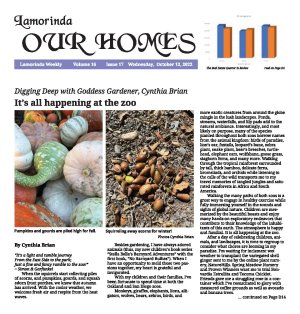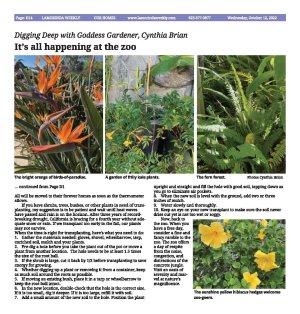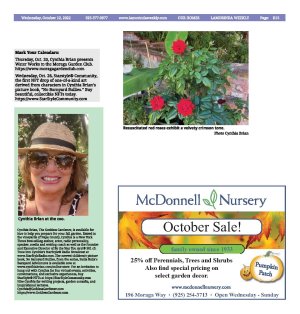|
|
Published October 12th, 2022
|
Digging Deep with Goddess Gardener, Cynthia Brian
|
| It's all happening at the zoo |
| By Cynthia Brian |
 |
| Pumpkins and gourds are piled high for fall. Photo Cynthia Brian |
"It's a light and tumble journey
 From the East Side to the park;
From the East Side to the park;
 Just a fine and fancy ramble to the zoo!"
Just a fine and fancy ramble to the zoo!"
 ~ Simon & Garfunkel
~ Simon & Garfunkel
 When the squirrels start collecting piles of acorns, and pumpkins, gourds, and squash adorn front porches, we know that autumn has arrived. With the cooler weather, we welcome fresh air and respite from the heat waves.
When the squirrels start collecting piles of acorns, and pumpkins, gourds, and squash adorn front porches, we know that autumn has arrived. With the cooler weather, we welcome fresh air and respite from the heat waves.
 Besides gardening, I have always adored animals (thus, my new children's book series "Stella Bella's Barnyard Adventures" with the first book, "No Barnyard Bullies"). When I have an opportunity to meld those two passions together, my heart is grateful and invigorated.
Besides gardening, I have always adored animals (thus, my new children's book series "Stella Bella's Barnyard Adventures" with the first book, "No Barnyard Bullies"). When I have an opportunity to meld those two passions together, my heart is grateful and invigorated.
 With my children and their families, I've been fortunate to spend time at both the Oakland and San Diego zoos.
With my children and their families, I've been fortunate to spend time at both the Oakland and San Diego zoos.
 Monkeys, giraffes, elephants, lions, alligators, wolves, bears, zebras, birds, and more exotic creatures from around the globe mingle in the lush landscapes. Ponds, streams, waterfalls, and lily pads add to the natural ambiance. Interestingly, and most likely on purpose, many of the species planted throughout both zoos borrow names from the animal kingdom: birds of paradise, lion's ear, foxtails, leopard's bane, zebra plant, snake plant, bear's breeches, turtlehead, elephant ears, wolfsbane, goose grass, staghorn ferns, and many more. Walking through the tropical rainforest surrounded by tall, thick bamboo, delicate ferns, bromeliads, and orchids while listening to the calls of the wild transports me to my travel memories of tangled jungles and saturated rainforests in Africa and South America.
Monkeys, giraffes, elephants, lions, alligators, wolves, bears, zebras, birds, and more exotic creatures from around the globe mingle in the lush landscapes. Ponds, streams, waterfalls, and lily pads add to the natural ambiance. Interestingly, and most likely on purpose, many of the species planted throughout both zoos borrow names from the animal kingdom: birds of paradise, lion's ear, foxtails, leopard's bane, zebra plant, snake plant, bear's breeches, turtlehead, elephant ears, wolfsbane, goose grass, staghorn ferns, and many more. Walking through the tropical rainforest surrounded by tall, thick bamboo, delicate ferns, bromeliads, and orchids while listening to the calls of the wild transports me to my travel memories of tangled jungles and saturated rainforests in Africa and South America.
 Walking the many paths of both zoos is a great way to engage in healthy exercise while fully immersing yourself in the sounds and sights of global nature. Children are mesmerized by the beautiful beasts and enjoy many hands-on exploratory endeavors that contribute to their knowledge of the inhabitants of this earth. The atmosphere is happy and familial. It is all happening at the zoo.
Walking the many paths of both zoos is a great way to engage in healthy exercise while fully immersing yourself in the sounds and sights of global nature. Children are mesmerized by the beautiful beasts and enjoy many hands-on exploratory endeavors that contribute to their knowledge of the inhabitants of this earth. The atmosphere is happy and familial. It is all happening at the zoo.
 After a day of celebrating children, animals, and landscapes, it is time to regroup to consider what chores are looming in my paradise. I'm waiting for inclement wet weather to transplant the variegated shell ginger sent to me by the online plant nursery, NatureHills. Spring Meadow Nursery and Proven Winners want me to trial Bouvardia Estrellita and Tecoma Chicklet. Friends gave me a struggling rose in a container which I've resuscitated to glory with measured coffee grounds as well as avocado and banana trees. All will be moved to their forever homes as soon as the thermometer allows.
After a day of celebrating children, animals, and landscapes, it is time to regroup to consider what chores are looming in my paradise. I'm waiting for inclement wet weather to transplant the variegated shell ginger sent to me by the online plant nursery, NatureHills. Spring Meadow Nursery and Proven Winners want me to trial Bouvardia Estrellita and Tecoma Chicklet. Friends gave me a struggling rose in a container which I've resuscitated to glory with measured coffee grounds as well as avocado and banana trees. All will be moved to their forever homes as soon as the thermometer allows.
 If you have shrubs, trees, bushes, or other plants in need of transplanting, my suggestion is to be patient and wait until heat waves have passed and rain is on the horizon. After three years of record-breaking drought, California is bracing for a fourth year without adequate snow or rain. If we transplant too early in the fall, our plants may not survive.
If you have shrubs, trees, bushes, or other plants in need of transplanting, my suggestion is to be patient and wait until heat waves have passed and rain is on the horizon. After three years of record-breaking drought, California is bracing for a fourth year without adequate snow or rain. If we transplant too early in the fall, our plants may not survive.
 When the time is right for transplanting, here's what you need to do:
When the time is right for transplanting, here's what you need to do:
 1. Gather the materials needed: gloves, shovel, wheelbarrow, tarp, enriched soil, mulch and your plants.
1. Gather the materials needed: gloves, shovel, wheelbarrow, tarp, enriched soil, mulch and your plants.
 2. Pre-dig a hole before you take the plant out of the pot or move a plant from another location. The hole needs to be at least 1.5 times the size of the root ball.
2. Pre-dig a hole before you take the plant out of the pot or move a plant from another location. The hole needs to be at least 1.5 times the size of the root ball.
 3. If the shrub is large, cut it back by 1/3 before transplanting to save energy for growing.
3. If the shrub is large, cut it back by 1/3 before transplanting to save energy for growing.
 4. Whether digging up a plant or removing it from a container, keep as much soil around the roots as possible.
4. Whether digging up a plant or removing it from a container, keep as much soil around the roots as possible.
 5. If moving an existing bush, place it in a tarp or wheelbarrow to keep the root ball intact.
5. If moving an existing bush, place it in a tarp or wheelbarrow to keep the root ball intact.
 6. In the new location, double-check that the hole is the correct size. If it is too small, dig it deeper. If it is too large, refill it with soil.
6. In the new location, double-check that the hole is the correct size. If it is too small, dig it deeper. If it is too large, refill it with soil.
 7. Add a small amount of the new soil to the hole. Position the plant upright and straight and fill the hole with good soil, tapping down as you go to eliminate air pockets.
7. Add a small amount of the new soil to the hole. Position the plant upright and straight and fill the hole with good soil, tapping down as you go to eliminate air pockets.
 8. When the new soil is level with the ground, add two or three inches of mulch.
8. When the new soil is level with the ground, add two or three inches of mulch.
 9. Water slowly and thoroughly.
9. Water slowly and thoroughly.
 10. Keep an eye on your new transplant to make sure the soil never dries out yet is not too wet or soggy.
10. Keep an eye on your new transplant to make sure the soil never dries out yet is not too wet or soggy.
 Now, back to the zoo. When you have a free day, consider a fine and fancy ramble to the zoo. The zoo offers a day of respite from the noise, congestion, and distractions of the concrete jungle. Visit an oasis of serenity and marvel at nature's magnificence.
Now, back to the zoo. When you have a free day, consider a fine and fancy ramble to the zoo. The zoo offers a day of respite from the noise, congestion, and distractions of the concrete jungle. Visit an oasis of serenity and marvel at nature's magnificence.
 Mark Your Calendars:
Mark Your Calendars:
 Thursday, Oct. 20, Cynthia Brian presents Water Works to the Moraga Garden Club.
https://www.moragagardenclub.com
Thursday, Oct. 20, Cynthia Brian presents Water Works to the Moraga Garden Club.
https://www.moragagardenclub.com
 Wednesday, Oct. 26, Starstyler Community, the first NFT drop of one-of-a-kind art derived from characters in Cynthia Brian's picture book, "No Barnyard Bullies." Buy beautiful, collectible NFTs today.
https://www.StarStyleCommunity.com
Wednesday, Oct. 26, Starstyler Community, the first NFT drop of one-of-a-kind art derived from characters in Cynthia Brian's picture book, "No Barnyard Bullies." Buy beautiful, collectible NFTs today.
https://www.StarStyleCommunity.com |
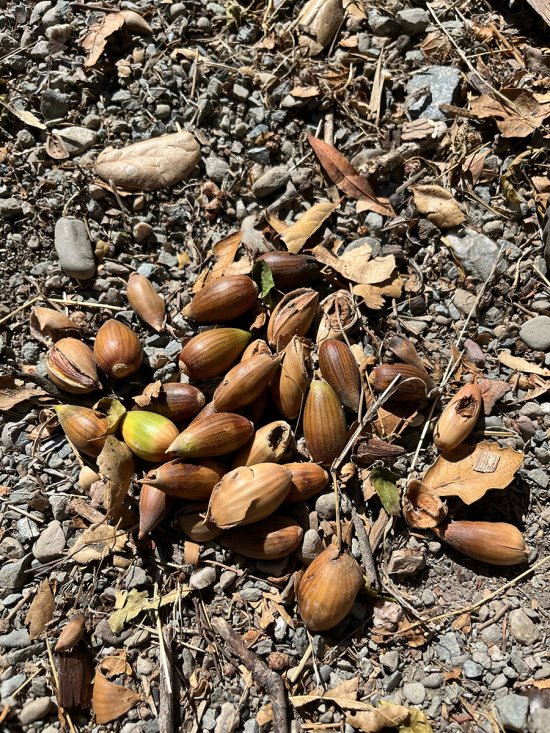 |
| Squirreling away acorns for winter! Photo Cynthia Brian |
 |
| The bright orange of birds-of-paradise. Photo Cynthia Brian |
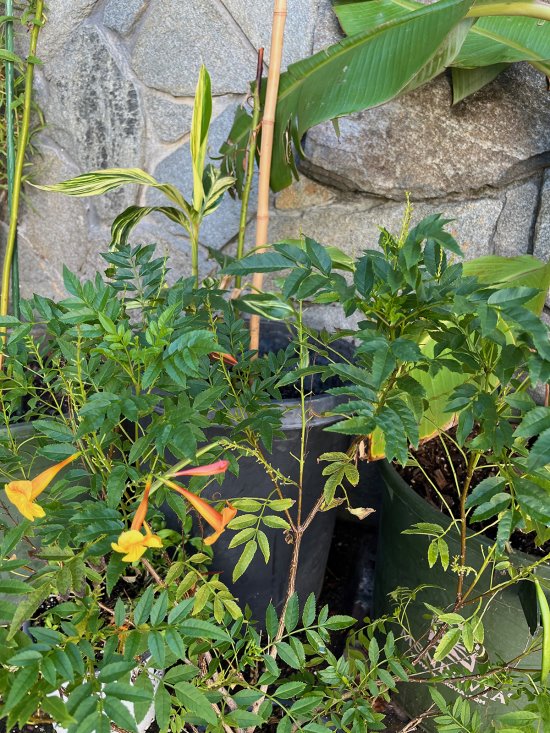 |
| A garden of frilly kale plants. Photo Cynthia Brian |
 |
| The fern forest. Photo Cynthia Brian |
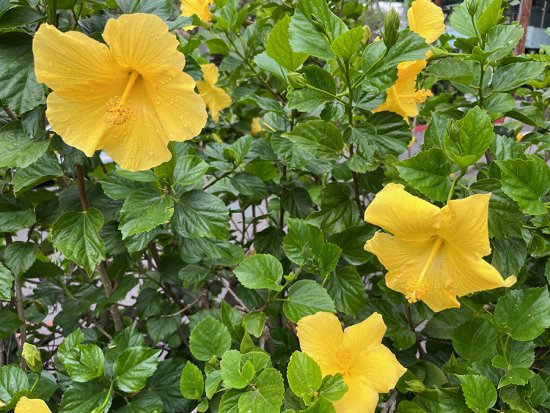 |
| The sunshine yellow hibiscus hedges welcome zoo-goers. |
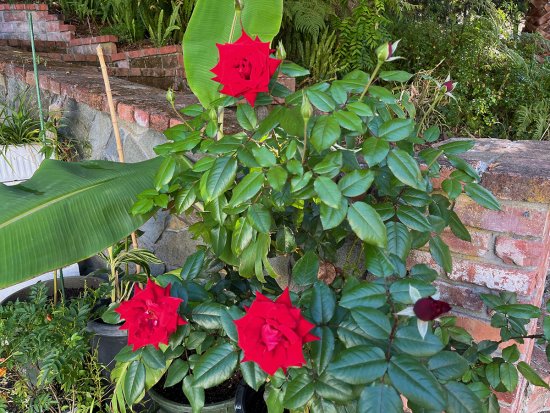 |
| Resuscitated red roses exhibit a velvety crimson tone. |
 |
Cynthia Brian at the zoo.
Cynthia Brian, The Goddess Gardener, is available for hire to help you prepare for your fall garden. Raised in the vineyards of Napa County, Cynthia is a New York Times best-selling author, actor, radio personality, speaker, media and writing coach as well as the Founder and Executive Director of Be the Star You Are!r 501 c3. Tune into Cynthia's StarStyler Radio Broadcast at
www.StarStyleRadio.com. Her newest children's picture book, No Barnyard Bullies, from the series, Stella Bella's Barnyard Adventures is available now at
www.cynthiabrian.com/online-store For an invitation to hang out with Cynthia for fun virtual events, activities, conversations, and exclusive experiences, buy StarStyler NFTs at https://StarStyleCommunity.com Hire Cynthia for writing projects, garden consults, and inspirational lectures.
Cynthia@GoddessGardener.com
https://www.GoddessGardener.com |
|
|
|










